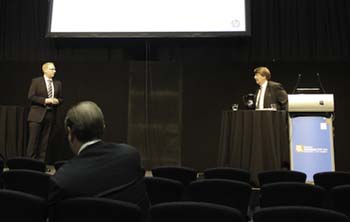HP tackles ATO automation, data recovery

Over the past two years the Australian Taxation Office has been working with enterprise IT giant HP Enterprise Services, formerly EDS, to improve its in-house IT operations, implementing automation and creating a new plan to virtualise the ATO's disaster recovery facilities.

HP's Jason Hodges and the ATO's David McMillen present to the 2010 Gartner Symposium. (Credit: Luke Hopewell/ZDNet Australia)
EDS partnered with the tax office in 2009 and set an agenda to implement and improve three areas of its IT operations. Later in the year the EDS brand was shelved for the moniker HP Enterprise Services.
Together, the ATO and HP Enterprise Services aimed to implement task and process automation to improve service delivery, virtualise disaster recovery facilities and invent a way to deploy new servers and hardware faster with less interaction.
The ATO made the decision to automate day-to-day tasks and processes to free up staff resources at different levels of technical support to work on more important things. Lower priority tasks that were previously conducted by Level One technical support staff became automated, minimising security risks and the chance of human error.
"We were asking junior staff to complete senior tasks under pressure, which often involved a lengthy set of processes. We thought there had to be a better way of doing that," said Jason Hodges of HP Enterprise Services.
"We even invested in detailed documentation, but the problem was the solutions were still prone to human error and can sometimes compromise information security," Hodges added.
As a result of task automation methods, senior Level Three technical support staff were able to commit their time to more critically pressing matters of technical support and maintenance.
HP and the ATO found that strong project governance was the key in automating operations.
"Governance is key. When we look at releasing automation as a capability within an organisation ... it's very important to track what you're doing in terms of delivering services," said Hodges.
After successfully automating key IT processes, HP worked with the ATO to virtualise the office's disaster recovery and emergency back-up services. Virtualisation of the disaster recovery side of the department meant that the tax office could reduce its dependence on large numbers of high storage servers. It also eliminated the constant duplication of back-up data.
"Data replication was occurring from production sites [to the disaster recovery] site, so we reduced the duplication of server infrastructure [to prevent that from happening]," said Hodges.
HP was able to impress upon the tax office it could also back-up non-core business applications onto the disaster recovery server, allowing faster recovery times for these non-critical applications in an emergency.
The tax office presented its results at the 2010 Gartner Symposium in Sydney today. The symposium is set to run through to tomorrow.